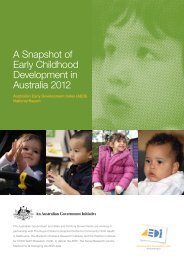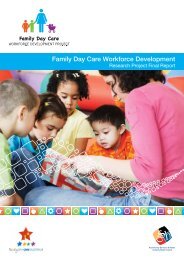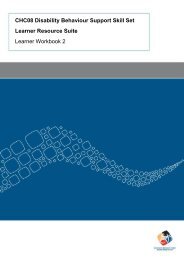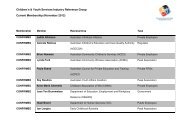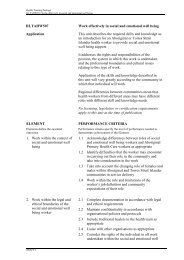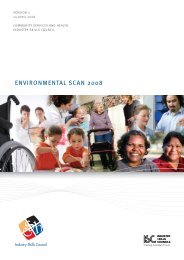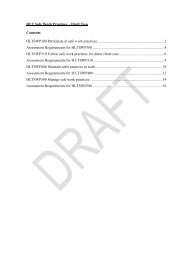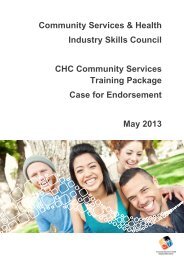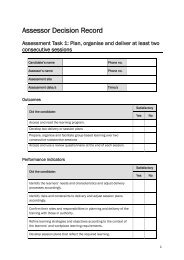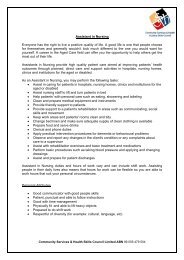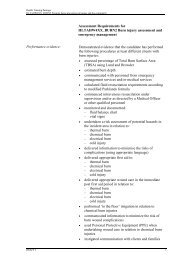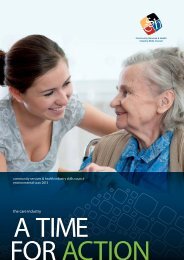Workforce Development Kit - Community Services & Health Industry ...
Workforce Development Kit - Community Services & Health Industry ...
Workforce Development Kit - Community Services & Health Industry ...
- No tags were found...
Create successful ePaper yourself
Turn your PDF publications into a flip-book with our unique Google optimized e-Paper software.
www.cshisc.com.au/cshiscContact us on: t (02) 8226 6600 f (02) 8226 6601PO Box H61, Australia Square 1215
<strong>Industry</strong> / Nationalplanning and strategySector / State / RegionEnterpriseIndividualperformance developmentproductivity & measurement<strong>Community</strong> <strong>Services</strong> and <strong>Health</strong><strong>Industry</strong> Skills Council<strong>Workforce</strong> <strong>Development</strong> <strong>Kit</strong>
<strong>Workforce</strong> <strong>Development</strong> <strong>Kit</strong>ContentsAbout the <strong>Community</strong> <strong>Services</strong> and <strong>Health</strong> <strong>Industry</strong> Skills Council 1CS&HISC <strong>Workforce</strong> <strong>Development</strong> Fact Sheet 2<strong>Workforce</strong> <strong>Development</strong> Challenges 3Skills Connect <strong>Workforce</strong> Planning & <strong>Development</strong> Model 4<strong>Workforce</strong> Planning Checklist 5Skills Connect Programs 10National <strong>Workforce</strong> <strong>Development</strong> Fund 10Snapshot 10Guide 11Case Studies 13<strong>Workforce</strong> English Language and Literacy Program 15Snapshot 15Guide 16Case Studies 18Australian Apprentices Mentoring Program 21Snapshot 21Guide 22Case Study 24Investing in Experience 25Snapshot 25Guide 26‘Bringing it all together’ Model 28Choosing an RTO Checklist 30
CS&HISCThe <strong>Community</strong> <strong>Services</strong> and <strong>Health</strong> <strong>Industry</strong> SkillsCouncil’s role is to lead and advise on workforcedevelopment and produce the industries’ nationalVocational Education and Training (VET) qualificationsand competency standards.AdviceWe share industry information with governmentagencies, employers, unions, Registered TrainingOrganisations, workers, so that decisions affecting ourindustries support the development and growth of ourworkforce and reflect client needs.SkillsWe develop and maintain the <strong>Community</strong> <strong>Services</strong>Training Package and the <strong>Health</strong> Training Package,and ensure consistency and quality in training, andsupport workforce development across our industries.<strong>Workforce</strong> developmentWe influence workforce development using a four-levelmodel, which supports activities such as:• National/industry: information and workforcepredictions on policy and reform implications• State/sector/region: developing models tooperate in specific locations that connectagencies working in the same sector to ensureoutcomes• Enterprise: showcasing and supporting bestpracticemodels for service delivery throughworkforce planning and development includingstrenghtening foundation skills• Individual: helping existing and potentialworkers access career advice and pathwayinformationCollaborationWe maintain a two-way relationship with employers,government advisory bodies, unions, peak bodies,associations, state and territory advisory boards andtraining providers to bridge the information gap onissues and activities impacting our workforce.CS&HISC is one of 11 nationallyrecognised <strong>Industry</strong> SkillsCouncils funded by the AustralianGovernment. It is a not-for-profitcompany limited by guarantee andgoverned by an independent andindustry-led Board of Directors.Our schedule of projects and other activities isalways publicly available on our website, and via ournewsletter.Contact us:workforcedevelopment@cshisc.com.auVisit us at www.cshisc.com.auContact us on: t (02) 8226 6600 f (02) 8226 6601PO Box H61, Australia Square 1215CS&HISC H<strong>Workforce</strong> <strong>Development</strong> <strong>Kit</strong> 1
CS&HISC<strong>Workforce</strong> <strong>Development</strong><strong>Community</strong> <strong>Services</strong> and <strong>Health</strong> <strong>Industry</strong> Skills Council(CS&HISC) sees the development of Australia’scommunity services and health workforce as a nationalpriority.<strong>Workforce</strong> development challenges inform thecontinuous improvement of training packages, programbrokerage, influence policy and drive priority workforcedevelopment activity at various levels as the diagrambelow shows.<strong>Workforce</strong> development activitiesCS&HISC works with stakeholders at each levelto identify workforce development challengesand to design solutions focused on planning andstrategy, performance development and productivityand measurement.Brokerage and fundingAustralian Government Skills Connect is an initiativewith programs designed to help link eligible Australianenterprises with the right funding to meet their skills andworkforce development needs:Sharing good practiceSharing interesting ideas, case studies, tools andinitiatives from our sectors promotes good practiceand allows organisations to learn from each other.Sharing your stories and experiences with the sectorwill strengthen networks, encourage collaboration, andcan assist you to access further workforce developmentopportunities.Network building and collaborationCS&HISC encourages networking and collaborationto share information and make links between activitiesacross the community services and health industries.We participate in a variety of regional, sector-basedand national networks to identify possible projectopportunities, and take the opportunity to present ourapproach to workforce development with stakeholders.• Accelerated Australian ApprenticeshipsInitiative• Australian Apprenticeships MentoringProgram• Investing in Experience• National <strong>Workforce</strong> <strong>Development</strong> Fund(NWDF)• Workplace English Language & LiteracyProgram (WELL)<strong>Industry</strong> Skills Councils are brokers for the NWDFand WELL programs, and can discuss your workforcedevelopment needs and provide you with information tocomplete an application under Skills Connect for one ormore programs.<strong>Industry</strong> / Nationalplanning and strategySector / State / RegionEnterpriseIndividualperformance developmentproductivity & measurement2CS&HISC <strong>Workforce</strong> <strong>Development</strong> <strong>Kit</strong>
<strong>Workforce</strong> Planning& <strong>Development</strong> ModelPHASE I – GETTING STARTEDDetermine your workforce future functionalrequirements using your organisation’s strategicplanning and budgeting processes.PHASE IV - MONITOR,EVALUATE AND REVISE• Assess what is working and what is notworking• Make adjustments to the workforceplan• Address new organisational issues that affectthe plan• Update the workforce plan and communicatethe planPHASE II - WORKFORCEANALYSIS• Analyse supply: your current workforce profile• Analyse demand: your future workforce profile• Analyse gap: identify discrepancy betweensupply and demand• Develop strategy: recommend solutions toreduce shortages in staff and the skills required– document this plan.PHASE III – IMPLEMENT PLAN• Communicate the workforce plan• Implement strategies to reduce gaps andshortages4CS&HISC <strong>Workforce</strong> <strong>Development</strong> <strong>Kit</strong>
<strong>Workforce</strong> planning checklist1. Purpose and scope of workforce planningWhy have you decided to develop a workforce plan and what is it intended to achieve? Have you considered:☐ Business goals and direction• Do you have a clear statement of your goals? E.g. business plan, strategic plan, operational plans?☐ Leadership and management• Do you have systems in place to support this plan? E.g. management, HR, communications, changemanagement?☐ Core capabilities and culture• What are capabilities required to deliver on this plan?• What values drive your organisation?• What culture do you need for success?• Does your workforce have the communication skills required to work effectively?☐ Critical job roles and workforce characteristics• What are the key workforce characteristics and critical job roles within your organisation, and what do yourequire to achieve workforce goals?☐ Professional and technical skills required• What skills are required to achieve your workforce goals?• What activities will you require to build and sustain these skills within the organisation?• Do these skills already exist in the organisation?CS&HISC <strong>Workforce</strong> <strong>Development</strong> <strong>Kit</strong> 5
2. Context of workforce planning☐ PEST analysisPolitical - Relevant policy, initiatives, workforce regulations, reformagendaEconomic - Funding mechanisms, pay rates, skill shortagesSocial - Demographic changes, changing client group orexpectations of services- Workplace culture and valuesTechnological - New equipment, new ways of doing workNotes:6CS&HISC <strong>Workforce</strong> <strong>Development</strong> <strong>Kit</strong>
3. <strong>Workforce</strong>Work backwards from the future to the present to help guide the information needed on your current workforce.Some information will be internal to the organisation and some will be external.☐ Future workforce• What will your future workforce look like/what do you need it to look like? E.g. number of staff, skills, corecapabilities, full time or part time, qualified, communication skills, consider culture fit• List the key characteristics that your future workforce should have☐ Current workforce• What data and information do you need about your workforce to complete the workforce plan? E.g.DataCurrent skills and qualifications:Recruitment - Are these internal or external?Retention/turnover - How will you gather this information?Demographic - Consider workforce culture and values.GenderAgeNotes:CS&HISC <strong>Workforce</strong> <strong>Development</strong> <strong>Kit</strong> 7
4. Bridge the gap - developing an action plan☐ Choose a template to document your plan, which will include items such as:CurrentworkforceFutureworkforceGapsPotentialactivitiesResourcesIncludingHR, changemanagementandPriority(High–Low)TimelineCurrent workforceFuture <strong>Workforce</strong>GapsPotential ActivitiesResources - Including HR, change management and communications plan, training providers etc.Priority (High – Low)Timeline8CS&HISC <strong>Workforce</strong> <strong>Development</strong> <strong>Kit</strong>
5. Monitoring and evaluating implementation☐ Reflect and document how well the plan has worked• Consider the outcomes you would like to achieve. Identify if there are any issues.• Consider activities and timelines - have they been completed?• Have priorities changed?6. Continuous review of the workforce plan• In consultation with managers, employees, training providers• Has the workforce plan helped managers to meet needs of the organisation?• Were all groups involved that needed to be?• Were the resources enough?• Were timelines realistic?• What needs to be added/taken out/changed?Notes:CS&HISC <strong>Workforce</strong> <strong>Development</strong> <strong>Kit</strong> 9
Skills Connect ProgramsNational <strong>Workforce</strong> <strong>Development</strong> Fund (NWDF)Description Who can apply? Eligibility ContributionThe program aims toincrease Australianworkers’ skills throughformal training nationallyendorsed qualification ora training package skillset.For new workers:Certificate II, III, IV,Diploma, AdvancedDiploma, VocationalGraduate Certificate andVocational GraduateDiploma.Organisations eligible toapply for funding includethe following:• Enterprises• Professionalassociations, industrybodies and other leadagents representing aconsortia of enterprises• Employment ServiceProvidersExisting workers andnew workers, includingcurrently unemployedjob seekers who willbe employed aftercompleting the training.Volunteers and thoseemployed in the generalgovernment sector inAustralian, State andTerritory GovernmentDepartments are noteligible for funding.Participating businesseswill contribute to thecost of training, basedon the size of thebusiness:Small (1 – 99) 33%Medium (100 – 199)50%Large (200 and above)66%For existing workers:Same as above, plusVocational GraduateCertificate andVocational GraduateDiploma.How to apply?Contact the <strong>Community</strong> <strong>Services</strong> & <strong>Health</strong> <strong>Industry</strong> Skills Council <strong>Workforce</strong> <strong>Development</strong> team:workforcedevelopment@cshisc.com.au10CS&HISC <strong>Workforce</strong> <strong>Development</strong> <strong>Kit</strong>
NATIONAL WORKFORCE DEVELOPMENT FUND - Quick Reference Guide forApplicantsThe National <strong>Workforce</strong> <strong>Development</strong> Fund (NWDF) is an Australian Government program that helps businessesidentify and address their current and future workforce development needs. The NWDF forms part of the AustralianGovernment Skills Connect initiative designed to link industry to funding for whole of workforce planning anddevelopment.Under the NWDF, businesses are able to apply for Government funding to support the training of their workersin areas of identified need. The program aims to help businesses lift their workforce capacity, provide Australianworkers with the opportunity to increase their skills through formal training and assist areas of the economy whereskilled workers are needed the most.Available Funding$700 million is available through the NWDF from 2011-12 to 2015-16. The National <strong>Workforce</strong> and ProductivityAgency is responsible for determining the industry sectors, regions and groups that will be prioritised for funding.Information about the priorities for funding in 2012-13 is available on the NWDF website.A fair proportion of funding will be available to support delivery in regional areas. This is expected to be at leastpopulation share or 32 per cent.A partnership with industryThe NWDF uses a partnership approach where <strong>Industry</strong> Skills Councils (ISCs) play a key role in administeringthe program. ISCs will assist businesses with identifying their training needs, selecting a Registered TrainingOrganisation to address these needs and monitoring the implementation of successful projects. This will ensurethat training proposals are driven by the needs of your business and allow you to decide what, how, where andwhen the training will be undertaken.Participating businesses will contribute to the cost of training. The level of Government support is based on the sizeof the business with additional support provided for smaller businesses:Size of Full Time Equivalent<strong>Workforce</strong>Australian GovernmentContribution (%)Participating OrganisationContribution (%)1 – 99 (small) 67 33100 – 199 (medium) 50 50200 and above (large) 34 66Who can apply?Organisations eligible to apply for funding include the following:• Enterprises• Professional associations, industry bodies and other lead agents representing a consortia of enterprises• Employment Service ProvidersCS&HISC <strong>Workforce</strong> <strong>Development</strong> <strong>Kit</strong> 11
Who can receive training?Training will be provided to existing workers and newworkers, including currently unemployed job seekerswho will be employed after completing the training.To be eligible for training, an individual must:• not have previously completed the qualification theyare applying for under the NWDF• be an Australian citizen, a permanent resident ofAustralia or a humanitarian refugee• be 17 years of age or over• satisfy course pre-requisites (such as adequateliteracy and numeracy) to effectively undertake thetraining• meet any licensing requirements for relevantqualificationsVolunteers and those employed in the generalgovernment sector in Australian, State and TerritoryGovernment Departments are not eligible for funding.What training will be delivered?Training must be either a nationally endorsedqualification or a Training Package Skills Setrecognised under the Australian QualificationsFramework.For new workers these qualifications can includeCertificate II, III, IV, Diploma, Advanced Diploma,Vocational Graduate Certificate and VocationalGraduate Diploma. For existing workers thesequalifications can include Certificate III, IV, Diploma,Advanced Diploma, Vocational Graduate Certificateand Vocational Graduate Diploma. Workersundertaking training in a Skills Set must already hold aqualification at a Certificate III level or above.application form available from TED Online athttps://tedonline.deewr.gov.au. Applications forfunding are now open and may be submitted untilall funding available for the financial year has beenallocated.An application for funding must include a costingjustification. Value for money is one of the criteria thatwill be used to evaluate applications. Applicants areencouraged to include a training needs analysis andworkforce development plan with their application.A workforce development plan should outline whatskills your employees have now, where you wantyour business to go, and what you need to do to getthere. For more advice on how to create a workforcedevelopment plan contact your relevant ISC.Where can I find out more?Further information about the National <strong>Workforce</strong><strong>Development</strong> Fund can be found at www.innovation.gov.au/nwdf. You can also email nwdf@innovation.gov.au. If you have a whole-of-workforce need visitAustralian Government Skills Connect atwww.skillsconnect.gov.au.You can also phone 13 38 73 between 8.00am and6.00pm, Monday to Friday.How to applyIf you are interested in applying you should first contactan ISC that is relevant to the industry you are operatingin. See www.isc.org.au to find the contact details ofall ISCs.Applications are submitted to an ISC using an on-line12CS&HISC <strong>Workforce</strong> <strong>Development</strong> <strong>Kit</strong>
National <strong>Workforce</strong> <strong>Development</strong>Fund Case StudiesUpskilling for mental health in aged care - A consortium approachThe National <strong>Workforce</strong> <strong>Development</strong> Fund (NWDF)provides scope for consortium applications which arebased on a region or sector coming together to respondto an identified challenge or need. Morshead Home inCanberra, ACT developed a project that brings togetherAged Care workers from across four services in theACT/NSW region. Through a strong regional networkand a good relationship with a training provider, theseservices were successful in receiving NWDF fundingfor Certificate IV in Mental <strong>Health</strong>. This group identifiedMental <strong>Health</strong> as a growing issue among their residentsand are up-skilling in order to continue to provide qualitycare.Morshead Home has acted as the Lead Organisationon the consortium application, with the other servicesidentified as Participating Employers. The employersworked together to develop the application andsubmitted it along with evidence of enterprise levelworkforce planning and regional networking. Theproject application provided a clear rationale for thedifferent types of work performed by the carers, and thebenefits that Mental <strong>Health</strong> training would have as theyexperienced higher numbers of mental illness diagnosisparticularly around dementia.This NWDF project is a good example of how a groupof services with similar needs have come together toimprove their skills and knowledge and form a regionalresponse to the challenges they face in the workplace.Key to their success is the ongoing support the learnershave from their managers, as well as the relationshipbetween the employers and the training provider toensure industry specific content and contextualisedtraining.Upgrading skills for workforce and training providersIntegratedLiving is a rural community managedbusiness providing services in aged care and disabilityacross Queensland, NSW and Victoria. IntegratedLivingreceived NWDF funding for a variety of qualificationsand skill sets including Home and <strong>Community</strong> Care,Disability <strong>Services</strong>, <strong>Community</strong> Sector Managementand Medical Assistance.IntegratedLiving wanted a holistic approach towardssustainable growth of their organisation, incorporatingup-skilling of existing workers to improve retention,training to support new job roles, and training anddevelopment of trainers and assessors with acommunity services background to support growth andlearning in the training industry. By linking their specificchallenges in a workforce plan, IntegratedLiving wassuccessful in receiving funding under the National<strong>Workforce</strong> <strong>Development</strong> Fund.By identifying workforce capacity and needs on anorganisation-wide scale, IntegratedLiving has ensuredthat a culture of learning is supported and sustainableoutcomes achieved. IntegratedLiving has workedclosely with their RTO to provide opportunities for theirworkforce to complete qualifications and continuingprofessional development relevant to their sector andexperience. By up-skilling the trainers and assessors inindustry specific qualifications and skill sets, the projecthas also given the RTO the opportunity to provide morecontextualised training, assessment and continuingprofessional development with good practice outcomes.Boarding Australia - contextualising training in the bushGeographic isolation, challenging climate conditionsand intensive client care are just some of the issuesfacing remote student accommodation workersthroughout rural Australia. It is a workforce that fliesunder the radar yet provides significant support toyoung people during their schooling away from home.Boarding Australia has recognised that formalqualifications would promote a uniform standardwithin the workforce and recognise the existing skillsand knowledge of workers. Using funding throughthe National <strong>Workforce</strong> <strong>Development</strong> Fund, BoardingAustralia are able to provide formal qualifications totheir existing workforce. As there is no existing specificqualification relating to student accommodation,Boarding Australia has engaged experienced trainerassessors from the sector to contextualise theCertificate IV in <strong>Community</strong> <strong>Services</strong> Work. Usingyouth based elective units and learning materialswith relevance to the student accommodation sector,Boarding Australia is training 45 learners in fourstates and territories. The flexibility provided bythe trainers is important due to the difference inlegislation such as mandatory reporting laws whichexist across each jurisdiction.CS&HISC <strong>Workforce</strong> <strong>Development</strong> <strong>Kit</strong> 13
The benefits of engaging the workforce in accreditedtraining is already becoming clear and participants arevaluing the learning experience as much as the skillsand knowledge gained during the process. As theseworkers are often isolated from the nearest town, or insome cases their own families, the opportunity to sharestories face-to-face with other learners is helping towork through issues that arise in their everyday workinglife.Amazing Family Day Care - NWDF & WELLAmazing Family Day Care is a recently establishedscheme providing training and career opportunities torefugee and migrant women on a subcontracting basisallowing them to enter the workforce and provide fortheir families, whilst working from home. The schemealso provides mentor support, and defines clear trainingand career pathways with positive socio-economiceffects for their families and community. In addition, thescheme employs non-carers who act in administration,recruitment and management roles and who are vitalto the ongoing operations of the scheme and theopportunities it provides.Under the NWDF, Amazing Family Day Care identified40 employees working within different functions ofthe scheme, to complete Certificate III in Children’s<strong>Services</strong>, Diploma of Children’s <strong>Services</strong>, andCertificate IV in Small Business Management. Theproject application also provided for 44 new workers(job seekers) who were being recruited locally in orderto meet the growing demands of the sector. Finally,the scheme identified English language, literacy andnumeracy (LLN) challenges, and sought funding underthe Workplace English Language and Literacy (WELL)program.WELL supports the development of LLN skills in theworkplace and complements existing workplace trainingprograms such as the National <strong>Workforce</strong> <strong>Development</strong>Fund. The funding offers employers the opportunity toimprove the LLN skills of their workforce.14CS&HISC <strong>Workforce</strong> <strong>Development</strong> <strong>Kit</strong>Amazing Family Day Care provides a good example ofhow funding can be used to allow employees underthe scheme to gain qualifications, whilst building theirLLN capacity, providing access to training support,and giving them a better chance at finishing theirqualifications and retaining employment.
<strong>Workforce</strong> English Language and Literacy Program (WELL)Program Description Who can apply? EligibilityWELL assistsorganisations to provideexisting employees withEnglish language,literacy and numeracytraining embedded invocational training andtailored to the needsof both workplace andworkers.Employers or groupsrepresenting employerssuch as:• <strong>Industry</strong> bodies• Group TrainingOrganisations• Registered TrainingOrganisations• Unions.Projects with less than10 participants are notnormally consideredviable.Participants must beAustralian citizens,permanent residents,New Zealandersresident in Australia for6 months, holders oftemporary protectionvisas plus:• Employed on a fulltime,part-time, casualor temporary basis;or under a contractof training (AustralianApprenticeship).Volunteers, temporaryvisa holders andinternational studentsare not eligible.Participating businesseswill contribute to the costof training, programs areencouraged to run on ayearly basis:First year – 25%Second and third year– 50%How to apply?Contact the <strong>Community</strong> <strong>Services</strong> & <strong>Health</strong> <strong>Industry</strong> Skills Council’s WELL Broker:wellbroker@cshisc.com.auCS&HISC <strong>Workforce</strong> <strong>Development</strong> <strong>Kit</strong> 15
WORKPLACE ENGLISH, LANGUAGE AND LITERACY PROGRAMQuick Reference GuideThe Workplace English Language and Literacy Program (WELL) is an Australian Government program thathelps businesses identify and address their current and future workforce development needs. WELL assistsorganisations to provide existing employees with English language, literacy and numeracy training embedded invocational training and tailored to the needs of both workplace and workers. WELL forms part of the AustralianGovernment Skills Connect initiative designed to link industry to funding for whole of workforce planning anddevelopment.Available Funding$95 million is available through the WELL program from 2012-13 through to 2014-15A partnership with <strong>Industry</strong>WELL uses a partnership approach where <strong>Industry</strong> Skills Councils (ISCs) play a key role in planning andestablishing WELL projects. This ensures that training will be driven by the needs of your business.Applicants can also apply directly via the WELL Coordinator in their state or territory.The Australian Government applies the following co-contribution model to WELL projects in order to assistemployers to develop their workforces through WELL training.YearAustralian GovernmentContribution (%)Participating OrganisationContribution (%)1 st Up to 75 At least 252 nd 50 503 rd 50 50Who can apply?Those able to apply for funding include employers or groups representing employers such as:• industry bodies• Group Training Organisations• Registered Training Organisations• unions.Applications must clearly demonstrate specific groups of people who have identifiable English language, literacyand/or numeracy needs. Projects with less than 10 participants are not normally considered viable.16CS&HISC <strong>Workforce</strong> <strong>Development</strong> <strong>Kit</strong>
Who can receive training?Participants must be one of the following:• an Australian citizen• a permanent resident of Australia• hold a permanent Australian visa• hold a New Zealand passport or have beenresident in Australia for at least six months prior tocommencing the training• hold a Temporary Protection visa.In addition, participants must be:• Employed on a full-time, part-time, casual ortemporary basis; or under a contract of training(Australian Apprenticeship). WELL funding is onlyavailable for Australian Apprentices undertaking anAustralian Apprenticeship that is on the Programapproved list.The Department of <strong>Industry</strong>, Innovation, ClimateChange, Science, Research and Tertiary Eduction,at its discretion, will consider projects that addressa demonstrated regional skill shortage that is notreflected in the approved list. Pre-employmentIndigenous Employment Program participants are alsoeligible for WELL training. All participants must haveEnglish language, literacy and/or numeracy proficiencyat levels 1, 2, and/or 3 on the Australian Core SkillsFramework i.e. below the level where a person is ableto communicate in English with sufficient accuracy tomeet specific workplace needs.What training will be delivered?Training must conform to the requirements of theAustralian Quality Training Framework (AQTF) andcomply with all legislation. Additionally, it should provideLLN skills that meet the employee’s employmentand training needs and be integrated with workplacetraining.To ensure that training is relevant to the workplace,it is generally aligned with units of competency fromNationally Endorsed Training Packages.How to applyApplications must be submitted online using theelectronic form found at the WELL website.www.innovation.gov.au/Skills/LiteracyAndNumeracy/WorkplaceEnglishLanguageAndLiteracyWhere can I find out more?Queries about WELL applications should be directedto your ISC WELL broker; or the WELL State/TerritoryCoordinator via the WELL Contact Centre: 13 38 73.If you have a whole of workforce proposal, orare interested in more than one program, furtherinformation can be found at Australian GovernmentSkills Connect (www.skillsconnect.gov.au).CS&HISC <strong>Workforce</strong> <strong>Development</strong> <strong>Kit</strong> 17
Workplace English, Language andLiteracy Program Case StudiesAround half of working age Australians have EnglishLanguage, Literacy and Numeracy (LLN) problems,preventing maximum workplace productivity andaffecting the ability of people to participate fully insociety. A common myth is that people with LLN issuesare only from non-English speaking backgroundsbut a high proportion are from English speakingbackgrounds, with varying skill levels that can hinderinterpersonal communication and make tasks difficult inwork environments.The ability to participate effectively in training and/oreducation is also impacted. The availability of programssuch as the Australian Government funded WorkplaceEnglish Language and Literacy (WELL) program canassist people to undergo accredited training whileconcurrently addressing LLN issues.Improving workplace communication skills ofemployees is the basis of the WELL program andwhen customised to include accredited training, theformal up skilling of participants benefits the individual,organisation and wider industry. Anecdotal feedbacktells us that people feel valued and more confident intheir job when employers invest in formal learning andaddressing LLN issues at the same time can enhancethe success of training.Older Care Lodge is an Aged Care facility inWestern Australia with a staff of 120. The mainbusiness of the Lodge is to maintain personal careand or other activities of living for elderly residentsin a residential facility. This includes creating andmaintaining individualised plans to sustain anindividual’s wellbeing: administration and management,property and ground maintenance, personal careworkers, enrolled and registered nurses.The Lodge has seen a turnover in staff annually ofabout 30%. The ability to retain staff would increaseresidents’ sense of wellbeing, as well as improvingcontinuity of care to the residents and contribute toteam cohesion and unity. Cultural sensitivity is an issuein the workplace with some staff from non-Englishspeaking backgrounds lacking an understanding ofAustralian work culture, government legislation andcompany procedures. As government legislativerequirements increase in the aged care industry, staffneed to be able to meet these additional demands.This includes knowledge and understanding of safetyissues, including the safety of staff and that of theresidents. Reading and following care plans is also amajor part of the job role of the carers and poor literacy/language skills can mean difficulty with comprehensionand plans not being adhered to.The Lodge liaised with the CS&HISC WELL brokerand together with an established RTO put in a WELLapplication for 56 of their staff to receive training in:• Language Literacy/ Numeracy Assessment (alignedto the Australian Core Skills Framework (ACSF))• Reading and completion of workplace specificforms• Writing and filling in care plans/ WHS forms/workplace emails• Oral communication for workplace needs,greetings, listening and understanding requests etc.• Numeracy for calculating medication dosages,numeracy for the workplace• Learning about cultural differences in the workplace• Computer literacy for workplace emails, care planreporting (where appropriate)These skills were aligned with competencies fromthe <strong>Community</strong> <strong>Services</strong> Training Package and theBusiness <strong>Services</strong> Training Package with an outcomeof improved Literacy/Language and Numeracy skillsand partial national qualifications. For example:CHCORG303A Participate effectively in the workenvironmentCHCORG3B Participating in Aged CareBSBCMM101A Apply basic communication skillsBSBOHS201A Participate in OHS process18CS&HISC <strong>Workforce</strong> <strong>Development</strong> <strong>Kit</strong>
Once the submission was approved by the DIISRTEoffice the organisation with assistance and guidancefrom the RTO and the broker formed a steeringcommittee to look at how and when the training wouldbe implemented.Charles Young Residential Care Centre, DunbarHomes and Pathways Training and Placements SAdeveloped and delivered a customised program toenhance workplace communication and promotea high performing environment and quality care fortheir residents, as they adjust to new leadership,new systems and more challenging care needs. Theprogram focusses strongly on English Language oralcommunication and literacy support for Culturallyand Linguistically Diverse (CALD) participants andfor employees identified as requiring improved LLNcommunication skills for work; and interpersonaland intercultural communication for the remainingstaff. Training includes targeted support in regards todocumentation, processes, systems and teamwork.MyVista, Rosewood and Centacare Employmentand Training WA’s WELL projects delivers on siteacross all sections of the organisation and addressspecific communication and documentation skillsrequired for carers, cleaners, kitchen and laundry staffjob roles. LLN training is designed to meet the needsof both the individual and the organisation that mainlyinclude LLN and Information communication technology(ICT) skills training, converting workplace documentsand instruction manuals into plain English, to improveinterface with workplace software, general self-esteemwith knowledge of and confidence in using technology.Eldercare the lodge and TAFE SA, the Lodge and TAFESA enhances daily communication and relationshipsbetween staff, their peers and residents. The programemphasises the relationship between cross culturalunderstanding and interaction. The focus is onthose employees new to Australian culture to trainin assertiveness, self-confidence and followingprocedures, as well as language and literacysupport. Cultural awareness/sensitivity and usingless judgmental responses is part of training for allstaff.CS&HISC <strong>Workforce</strong> <strong>Development</strong> <strong>Kit</strong>19
Wagga Wagga City Council facilitated a WELLfunded program under the banner of CoordinatedApproach Recognising Educator Role andResponsibilities for Family Day Care educatorsin the local region (CARER). The Council sawopportunity to link the requirement of educators toobtain the Certificate III in Children’s <strong>Services</strong> as aminimum industry standard, and the need to foster thedevelopment of language, literacy and numeracy skillsof the workforce by using WELL funding.Using the <strong>Community</strong> <strong>Services</strong>& <strong>Health</strong> <strong>Industry</strong> Skills Councilas a broker to assist with theapplication process and accessthe funding, the Council engagedan industry steering committeewith representation from theFamily Day Care educatorworkforce and developed theprogram which has seen morethan 49 participants commencea pathway towards gainingthe Certificate III in Children’s<strong>Services</strong> or participate in specialistLLN training.In collaboration with Riverina Institute as the partnerRegistered Training Organisation, the Council identifiedkey competencies from the Certificate III in Children’s<strong>Services</strong> that were particularly suitable to embedthe five core skills of learning, reading, writing, oralcommunication and numeracy. Not only did the Councilrecognise the need for targeted LLN support in thesecore competencies, some of which deal with regulatoryrequirements, but it was also recognised as a potentialarea of risk should the workers feel unconfident toexplain these requirements to the parents of thechildren in their care.<strong>Community</strong> <strong>Services</strong> Manager Edwina Marks fromWagga Wagga City Council attributes the success ofthe program to a number of factors - the flexibility of theWELL workers engaged in the program, customiseddelivery by integrating LLN support and specialistLLN trainers and resources to support the deliveryof the program. As a result, more than 50% of theWagga Wagga regional Family Day Care workforcenow on their way towards obtainment of the mandatedqualification requirement for Children’s <strong>Services</strong>.Riverina TAFE developed a training program forunemployed Aboriginal and/or Torres Strait Islanderparticipants in 4 different locations within theregion. The project consisted of 12 weeks full timestudy and incorporates work experience. LLN capacitywas built in Allied <strong>Health</strong> units of competency and theirfoundation skills in order to assist participants to enterthe workforce.The Islamic Women’s Association Queensland’sWELL Program offers LLN one-on-one support toparticipants that are undergoing a Certificate III inAged Care and LLN training to participants who havea Certificate III In Aged Care to support their ability towrite reports, fill out workplace forms, read rosters,schedules, policies & procedures and communicatemore effectively.The Human <strong>Services</strong> Training Advisory Counciland the Julalikari Council Aboriginal Corporationin Tennant Creek developed a WELL Program totrain <strong>Community</strong> Service Workers by incorporatinglanguage, literacy and numeracy into the Certificate IIIin <strong>Community</strong> <strong>Services</strong> Work. The training supportsworkplace activities in order to improve the completionof workplace tasks and to lead to an improvedservice delivery and career pathways for the courseparticipants.20CS&HISC <strong>Workforce</strong> <strong>Development</strong> <strong>Kit</strong>
Australian Apprenticeships Mentoring Program (AAMP)Program Description Who can apply?Funding to support targetedmentoring to help AustralianApprentices successfully progressthrough their Apprenticeships.Mentoring may also involvesupport to the AustralianApprentices employers orsupervisors to encourage apositive employment relationshipand better support for AustralianApprentices. Support will targetAustralian Apprentices who maybe in the first year of training andare most likely to benefit fromadditional support.• Professional associations,industry bodies and LeadOrganisations representing aconsortium• Employers• Employment-related serviceproviders such as AustralianApprenticeships Centres.Partnership arrangements areencouraged as they enableprojects to be delivered byorganisations which individuallymight not have all of the requiredexpertise, but in partnership withanother specialised organisationcould meet the requirements tomore effectively deliver projectsunder the program.Australian Apprentices:• in industries or occupations withcurrent or emerging skills need,particularly those employedin small to medium sizedbusinesses• who may face additionalbarriers to participation,including Australians ofIndigenous background, thosewith a disability, those of matureage,vulnerable youth, thoseliving in regional and remotelocations, men and womenundertaking non-traditionaloccupations, the long-termunemployed, Australian SchoolbasedApprentices, and thosewho may need additional supportas they undertake their training.ContributionCo-contribution of funding from applicants is encouraged to deliver projects but is not compulsory.How to apply?If you are interested in applying visit the website atwww.australianapprenticeships.gov.au/MentoringPackage/MentoringProgramHowToApply.aspYou can also make contact via email skillsconnect@innovation.gov.auYou can also phone 13 38 73 between 8.00 am to 6.00 pm, Monday to Friday.CS&HISC <strong>Workforce</strong> <strong>Development</strong> <strong>Kit</strong> 21
• a foreign national with permanent residencystatus• a New Zealand passport holder who has resided inAustralia for at least six months• a foreign national with a Trade Skills Training Visa(subclass 471).What will be delivered?The program will fund targeted mentoring and mayalso provide support for employers and supervisorsto encourage a positive employment relationship andbetter support for Australian Apprentices.How to applyApplications are submitted using an application formavailable from the Australian Apprenticeships MentoringProgram website www.australianapprenticeships.gov.au/MentoringPackage/MentoringProgramHowToApply.asp.Applications for funding can be submitted to theDepartment at any time. Early applications areEncouraged to ensure availability of funding.Where can I find out more?If you are interested in applying visit the websiteat www.australianapprenticeships.gov.au/MentoringPackage/MentoringProgramHowToApply.Visit (www.skillsconnect.gov.au).CS&HISC <strong>Workforce</strong> <strong>Development</strong> <strong>Kit</strong> 23
936. A pesar de que esto no ha significado que los procesos electorales estén libres dedenuncias 24 , la Comisión valora que se haya regenerado la confianza en los resultados electoralesemitidos por el Consejo Nacional Electoral. La certeza en los resultados en las urnas legitima el poderque ejercen las autoridades elegidas.37. Ahora bien, como ha señalado la Comisión, la participación política y los derechospolíticos no se refieren solamente a la vigencia y posibilidad de ejercer el derecho del voto o laposibilidad de ser elegido en elecciones 25 , sino que implican necesariamente la vigencia de toda otraserie de derechos y garantías para asegurar una plena vigencia de la democracia. De tal forma, losprocesos electorales, para ser justos y equitativos, requieren de ciertas condiciones.38. Al respecto, información recibida por la CIDH en el marco de sus audiencias 26señala que los más recientes procesos electorales en Venezuela han carecido de los elementos deequidad en tanto ha existido un uso inadecuado de las estructuras del Estado para favorecer lascampañas electorales. Particularmente, en relación con los más recientes procesos electorales de 23de noviembre de 2008 y de 15 de febrero de 2009, información recibida por la Comisión hacereferencia a la supuesta ausencia de control electoral por parte del Consejo Nacional Electoral, no encuanto al conteo de los votos sino respecto del proceso electoral en sí mismo.39. Se informó a la Comisión que el Presidente de la República habría utilizado lafacultad de realizar cadenas de radio y televisión para promover candidatos de su lista así comotambién para promover la opción oficialista en el proceso de referendo, sin que el Consejo NacionalElectoral se pronuncie sobre la materia. Asimismo, se informó que durante las campañas seregistraron agresiones verbales provenientes del Presidente de la República y de otras autoridadespúblicas, las mismas que fueron transmitidas en cadenas de radio y televisión.40. En sus observaciones al presente Informe, el Estado señaló que esto es “muysubjetivo, y es una manera de los candidatos opositores para justificar sus derrotas electorales” 27 .Además destacó que “algunas Ong’s venezolanas y partidos de oposición han señalado que el uso delas cadenas informativas por radio y televisión por parte del gobierno nacional es algo ilegal, sinembargo hemos demostrado que es una obligación constitucional del Estado, conforme a losartículos 57 y 58 de la Constitución, mantener informado (sic) a los ciudadanos y ciudadanas, asímismo lo establece la Ley de Responsabilidad Social en Radio y Televisión” 28 . Con respecto a las24Se ha señalado, por ejemplo, que para las elecciones del 15 de febrero de 2009 no se abrió el registroelectoral a posibles electores que alcanzaron la mayoría de edad desde el registro llevado a cabo para laselecciones anteriores, impidiendo su derecho a ejercer el voto.párr. 220.25 CIDH. Informe Anual 2006. Capítulo IV: Desarrollo de los Derechos Humanos en la Región. Venezuela,26Información aportada por los peticionarios a la CIDH. Audiencia sobre la Situación deInstitucionalidad y los Derechos Humanos en Venezuela. 134° Período Ordinario de Sesiones, 24 de marzo de2009.27 República Bolivariana de Venezuela. Ministerio del Poder Popular para las Relaciones Exteriores.Agente del Estado para los Derechos Humanos. Observaciones al Proyecto de Informe Democracia y DerechosHumanos en Venezuela. Nota AGEV/000598 de 19 de diciembre de 2009, página 23.28República Bolivariana de Venezuela. Ministerio del Poder Popular para las Relaciones Exteriores.Agente del Estado para los Derechos Humanos. Observaciones al Proyecto de Informe Democracia y DerechosHumanos en Venezuela. Nota AGEV/000598 de 19 de diciembre de 2009, página 22.
of Education and Communities, Catholic Education and other supporting organisations such as Youth Connectionsproviders. Project partner roles include project governance, recruitment of mentors and referral of mentees.Investing in Experience (IIE)Program Description Who can apply? EligibilityGrants of up to$4,400 are availableto employers to assistwith the costs ofemployees completinga skills assessmentor Recognition ofPrior Learning by aRegistered TrainingOrganisationto complete aqualification (CertificateIII to AdvancedDiploma) or anapproved Skill Set.• Employers from allemployment sectors,including local,State and TerritoryGovernments.• Small businessowners, including soletraders, operatingin Australia who arethemselves matureage workers.All industry sectors areeligible.• Mature age worker 50years of age or older• Employed for financialremuneration for 14hours or more perweekor, in the case ofsmall businesses, selfemployed• Australian citizen (orpermanent resident orhumanitarian refugee)• wishing to obtainformal qualificationsand wanting tohave experiencerecognised.Funds are paid toemployers in twoinstalments:• $3,300 (includesGST) is paid tothe employer uponcompletion of askills assessment orRecognition of PriorLearning processconducted by aRegistered TrainingOrganisation• $1,100 (includesGST) is paid tothe employer uponcompletion of anyidentified gap training.How to apply?For more information about the program, including eligibility rules, see www.skillsconnect.gov.au.You can also make contact via email skillsconnect@innovation.gov.au.You can also phone 13 38 73 between 8.00 am to 6.00 pm, Monday to Friday.CS&HISC <strong>Workforce</strong> <strong>Development</strong> <strong>Kit</strong> 25
BRINGING IT ALL TOGETHERA collaborative <strong>Workforce</strong><strong>Development</strong> ModelIn 2011, a group of employers in the Mid North Coastof New South Wales created a workforce developmentprogram with the aim of increasing the supply ofwork-ready applicants with the right skills, knowledge,attitudes and behaviours necessary to secureemployment in the Aged Care industry. The ‘BringingIt All Together’ project demonstrates how collaborativeworkplace based programs can deliver workforcedevelopment outcomes for employers, employees andjob seekers.The program includes a seriesof workforce participation tools,a preparatory program forjobseekers which introduces andattracts new entrants to the AgedCare sector, and ongoing careerdevelopment opportunities forexisting workers.‘Bringing it all Together’ developed an <strong>Industry</strong>-led<strong>Workforce</strong> <strong>Development</strong> Model for the local Aged Careindustry. The model itself is ‘transferable’, and providesthe guidance for skill building and career advancementopportunities in any industry.This project was based on a collaborative processand a multidisciplinary team, which included a fundedcoordinator. Using a systems approach, the teamanalysed the conditions that had precipitated thecurrent system, the cost/benefits of changing versusnot changing, and created a shared vision of the finalgoal.Once the team defined the parameters of the project,an <strong>Industry</strong> Reference Group was established andtasks were assigned, including the review of numerousinternal documents, policies, and procedures along withanecdotal research on how other organisations haveapproached this issue.Key areas were identified including attraction, selection,recruitment and retention, training, promotionalpractices, and present and future staff needs.During the project, 11 employers created a partnershipwith NSW State Training <strong>Services</strong>, two Job <strong>Services</strong>providers, two Apprenticeship Centres, one RegisteredTraining Organisation CS&HISC:• Approximately 500 job seekers attendedinformation sessions and participated in the project‘filter’ process• Approximately 100 jobseekers participated in a fourweek unpaid pre-vocational program• Approximately 50 of these jobseekers where placedinto traineeships and are currently undergoingtraining. Currently the retention is 100%• 688 existing staff are being skilled under theNational <strong>Workforce</strong> <strong>Development</strong> Program.The outcomes of this project include:• An in depth understanding of the region’s aged careworkforce issues and a regional workforce planowned by the aged care providers• A ‘supply chain’ for appropriately selected andtrained employees for the local aged care industry,which includes partnerships between local Jobs<strong>Services</strong> providers as well as a developing VET inSchools program• Career progression and opportunities fordevelopment for aged care staff in the region• Good working partnerships with responsiveemployment, education and training providers inthe region• <strong>Workforce</strong> Participation Tools: Dedicated AgedCare Career Information Page, industry posters andguides.28CS&HISC <strong>Workforce</strong> <strong>Development</strong> <strong>Kit</strong>
The role of the funded Coordinator was fundamental in‘Bringing it All Together’. Now that the links are madeand the partnerships formed, the program is continuingwithout this support.The ‘Bringing it all Together’ workforce developmentmodel will help ensure a well-trained, more highlyskilled workforce that is flexible, more adaptable,and generally better equipped to handle the complexwork environment faced by today’s environmentalhealth professionals. Staff will now also have moreopportunities for career pathways and chances, foradvancement.Bringing it all togetherThe strategy proposed in this project is the essentialfirst step, which will provide subsequent steps inbuilding a complete workforce development programfor those involved.The tools developed from this project, will not onlyallow good practice to continue, but to be shared inmany other regions throughout Australia.AttractSelect<strong>Workforce</strong>ParticipationRecruitTrainEmploy Retain ToolsCS&HISC <strong>Workforce</strong> <strong>Development</strong> <strong>Kit</strong> 29
Registered Training Organisation (RTO) ChecklistEmployers have a choice about who they can use. An RTO can work with employers to identify and addressworkforce development needs twith sustainable and flexible solutions.How experienced is the RTO? Y/N CommentsHas the RTO provided training in yourindustry before?Can the RTO help you to identify andaddress your workforce developmentneeds?Can they provide the contacts of otherorganisations they have worked with asreferences. Ask if you are able to speak tothem.Ask who will be delivering the training. Doall the trainers and assessors for the coursehave the current industry knowledge,experience and appropriate qualifications?Can they provide details of their experience(ask to read their CVs check theirreferences etc)? Ask to speak to them.How flexible is the RTO? Y/N CommentsIs the RTO flexible about providing trainingand assessment where and when youneed it, e.g. on site, off site, before or afterhours?Can the RTO provide training in a waywhich suits your business and individualstaff needs - e.g. on the job, web-based,and can they provide language, literacyand/or numeracy support if required?Does the RTO use existing training andassessment materials or are they tailormade to your business needs?Can the RTO assess your staff’s priorlearning and experience?30CS&HISC <strong>Workforce</strong> <strong>Development</strong> <strong>Kit</strong>
Will the RTO work with the relevant stafffrom your enterprise in designing theworkforce development program? Canyour staff provide some of the training inpartnership?Will the RTO coordinate additional,specialist training requirements that theyare unable to provide themselves?How much will it cost? Y/N CommentsWhat are the costs and breakdown, is iteasy to understand?Is the RTO quoting a cost per trainee, orcost per units of training each individualrequires? How is the assessment of priorlearning costed?Is the course provider willing to havea contract with you clearly stating theirresponsibilites and yours, and a key contactperson?Can the RTO explain how their serviceswill benefit your business and provide ananalysis of the Return on Investment (ROI)?Is the RTO committed to a long termpartnership with your business, how is thisdemonstrated and what ongoing supportwill they provide? Will they work with you toevaluate the training?Will your staff gain a nationally recognisedqualification at the end of the training (if thisis your objective)?Will the RTO provide records of stafftraining participation and assessment?CS&HISC <strong>Workforce</strong> <strong>Development</strong> <strong>Kit</strong> 31
Useful websitesGENERALACT GovernmentAustralian Government - <strong>Health</strong> <strong>Services</strong>Centrelink<strong>Community</strong> <strong>Services</strong> and <strong>Health</strong> <strong>Industry</strong> Skills Council<strong>Community</strong> <strong>Services</strong> and <strong>Health</strong> ITAB<strong>Community</strong> <strong>Services</strong>, <strong>Health</strong> & Education TrainingCouncil<strong>Health</strong> and <strong>Community</strong> <strong>Services</strong> <strong>Workforce</strong> CouncilHuman <strong>Services</strong> Training Advisory CouncilRegional Education, Skills and Jobs Coordinators(RESJs)Skills ConnectSkills Tasmaniawww.act.gov.auwww.humanservices.gov.auwww.cshisc.com.auwww.csh-itab.com.auwww.csheitc.org.auwww.workforce.org.auwww.hstac.com.auwww.australia.gov.au/topics/health-and-safety/healthserviceshttp://deewr.gov.au/regional-education-skills-and-jobscoordinatorswww.skillsconnect.gov.auwww.skills.tas.gov.auJobs <strong>Services</strong> ProvidersJob NetworkJobs <strong>Services</strong> Australiawww.jobsearch.gov.au/default.aspxhttp://deewr.gov.au/job-services-australia-jsaGovernmentCentrelinkDepartment of Education, Employment and WorkplaceRelationsDepartment of Families, Housing, <strong>Community</strong> <strong>Services</strong>and Indigenous AffairsDepartment of <strong>Health</strong> and AgeingTraining.gov.auDepartment of <strong>Industry</strong>, Innovation, Climate Change,Science, Research and Tertiary EducationAustralian Workplace Productivity Commissionwww.centrelink.gov.auwww.deewr.gov.auwww.fahcsia.gov.auwww.health.gov.auwww.training.gov.auwww.innovation.gov.auwww.innovation.gov.auPEAK BODIESAmbulanceCouncil of Ambulance AuthoritiesSt John Ambulance Australiawww.caa.net.auwww.stjohn.org.auChildren’s <strong>Services</strong>Australian Children’s Education & Care QualityAuthority (ACECQA)<strong>Community</strong> Child Care Cooperativewww.acecqa.gov.auwww.ccccnsw.org.au32CS&HISC <strong>Workforce</strong> <strong>Development</strong> <strong>Kit</strong>
Early Childhood AustraliaFamily Day Care AustraliaNetwork of Outside School Hours <strong>Services</strong> Australiawww.earlychildhoodaustralia.org.auwww.familydaycare.com.auwww.netoosh.org.au/noshsaDentalAustralian Dental AssociationAustralian Dental CouncilAustralian Dental and Oral <strong>Health</strong> Therapists’Associationwww.ada.org.auwww.adc.org.auwww.adohta.net.auNursing and Aged CareAged and <strong>Community</strong> <strong>Services</strong> Association (NSW &ACT)Australian Nursing FederationLeading Aged <strong>Services</strong> Australiawwww.agedservices.asn.auwww.anf.org.auwww.lasa.asn.auRural and Remote <strong>Health</strong><strong>Services</strong> for Australian Rural and Remote Allied <strong>Health</strong>www.sarrah.org.auAboriginal and/or Torres Strait Islander <strong>Health</strong>Aboriginal <strong>Health</strong> and Medical Research Council ofNSWNational Aboriginal <strong>Community</strong> Controlled <strong>Health</strong>OrganisationQueensland Aboriginal and Islander <strong>Health</strong> CouncilVictorian Aboriginal <strong>Community</strong> Controlled <strong>Health</strong>Organisation Inc.www.ahmrc.org.auwww.naccho.org.auwww.qaihc.com.auwww.vaccho.org.auAllied <strong>Health</strong>Allied <strong>Health</strong> Professions Australiawww.ahpa.com.auDisabilityNational Disability <strong>Services</strong>www.nds.org.au<strong>Community</strong> <strong>Services</strong>Australian Council of Social Servicewww.acoss.org.auMental <strong>Health</strong><strong>Community</strong> Mental <strong>Health</strong> AustraliaMental <strong>Health</strong> Council of Australiawww.cmha.org.auwww.mhca.org.au<strong>Workforce</strong> Planning Tools<strong>Workforce</strong> Blueprint<strong>Workforce</strong> Planning AustraliaInnovation and Business Skills Australiawww.workforeceplanningtools.com.auwww.workforceplanning.com.auwww.ibsa.org.au



